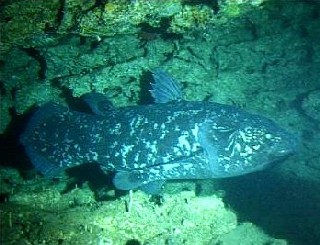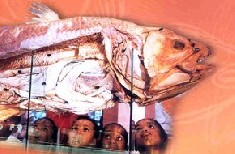Coelacanth project takes off
12 April 2002
The coelacanth, a prehistoric fish that has lived in the Indian Ocean for 400 million years, and thought until 1938 to be extinct, is now the subject of a government-backed research project off the coast of Sodwana Bay, coupled with an educational programme in rural schools in KwaZulu-Natal.
The discovery of the world's most accessible population of coelacanths near Sodwana on the north-eastern coast of KwaZulu-Natal in November 2000 placed South Africa in a unique position to lead a national and international endeavour to understand this "living fossil".
The first discovery of a live coelacanth - in a trawl net in the East London harbour in 1938 - was hailed internationally as the most important zoological find of the century.
Until then the fish was known only from fossils dating back 400 million years, and was thought have become extinct around 70 million years ago. With its extraordinary leg-like fins, "Old Fourlegs" was thought to be the
evolutionary great-grandfather of the reptiles, mammals - and humankind.
 The coelacanth first discovered in November 2000 and rediscovered on 31 March 2002. The divers who first found the fish named it 'Harding', after cameraman Dennis Harding, who died after a too rapid ascent from over 100 metres. (Picture: SA Coelacanth Conservation and Genome Resource Programme)
The coelacanth first discovered in November 2000 and rediscovered on 31 March 2002. The divers who first found the fish named it 'Harding', after cameraman Dennis Harding, who died after a too rapid ascent from over 100 metres. (Picture: SA Coelacanth Conservation and Genome Resource Programme)
Arts, Culture, Science and Technology Minister Ben Ngubane launched the Coelacanth Research Project at Sodwana Bay on 12 April. The project pulls in the South African Coelacanth Conservation and Genome Research Programme – established in February with R10-million in government funding – and partners from the Southern African Development Community, Europe, North America and Singapore.
A team of experts, including world-famous Professor Hans Fricke of the German Max Planck Institute, will
study the marine dinosaurs with the help of
Jago, a submersible two-man craft custom-made for studying the coelacanth and supplied by Germany under a German/South African science, research and technology co-operation agreement.
The South African research team on board the Fisheries Research ship
Algoa is led by Dr Tony Ribbink and Mike Roberts from the South African Institute for Aquatic Biodiversity.
They will seek initially to establish the size and environment of Sodwana’s coelacanth population, and hope to fit some of the fish with acoustic tags and tracking devices in order to monitor their movements. The coelacanth location has been sealed off to the public.
SouthAfrica.info reporter
 The coelacanth first discovered in November 2000 and rediscovered on 31 March 2002. The divers who first found the fish named it 'Harding', after cameraman Dennis Harding, who died after a too rapid ascent from over 100 metres. (Picture: SA Coelacanth Conservation and Genome Resource Programme)
Arts, Culture, Science and Technology Minister Ben Ngubane launched the Coelacanth Research Project at Sodwana Bay on 12 April. The project pulls in the South African Coelacanth Conservation and Genome Research Programme – established in February with R10-million in government funding – and partners from the Southern African Development Community, Europe, North America and Singapore.
A team of experts, including world-famous Professor Hans Fricke of the German Max Planck Institute, will
study the marine dinosaurs with the help of Jago, a submersible two-man craft custom-made for studying the coelacanth and supplied by Germany under a German/South African science, research and technology co-operation agreement.
The South African research team on board the Fisheries Research ship Algoa is led by Dr Tony Ribbink and Mike Roberts from the South African Institute for Aquatic Biodiversity.
They will seek initially to establish the size and environment of Sodwana’s coelacanth population, and hope to fit some of the fish with acoustic tags and tracking devices in order to monitor their movements. The coelacanth location has been sealed off to the public.
SouthAfrica.info reporter
The coelacanth first discovered in November 2000 and rediscovered on 31 March 2002. The divers who first found the fish named it 'Harding', after cameraman Dennis Harding, who died after a too rapid ascent from over 100 metres. (Picture: SA Coelacanth Conservation and Genome Resource Programme)
Arts, Culture, Science and Technology Minister Ben Ngubane launched the Coelacanth Research Project at Sodwana Bay on 12 April. The project pulls in the South African Coelacanth Conservation and Genome Research Programme – established in February with R10-million in government funding – and partners from the Southern African Development Community, Europe, North America and Singapore.
A team of experts, including world-famous Professor Hans Fricke of the German Max Planck Institute, will
study the marine dinosaurs with the help of Jago, a submersible two-man craft custom-made for studying the coelacanth and supplied by Germany under a German/South African science, research and technology co-operation agreement.
The South African research team on board the Fisheries Research ship Algoa is led by Dr Tony Ribbink and Mike Roberts from the South African Institute for Aquatic Biodiversity.
They will seek initially to establish the size and environment of Sodwana’s coelacanth population, and hope to fit some of the fish with acoustic tags and tracking devices in order to monitor their movements. The coelacanth location has been sealed off to the public.
SouthAfrica.info reporter
 The Coelacanth Research Project: bringing the 'living fossil' into rural classroomsPicture: National Research Foundation
The Coelacanth Research Project: bringing the 'living fossil' into rural classroomsPicture: National Research Foundation




